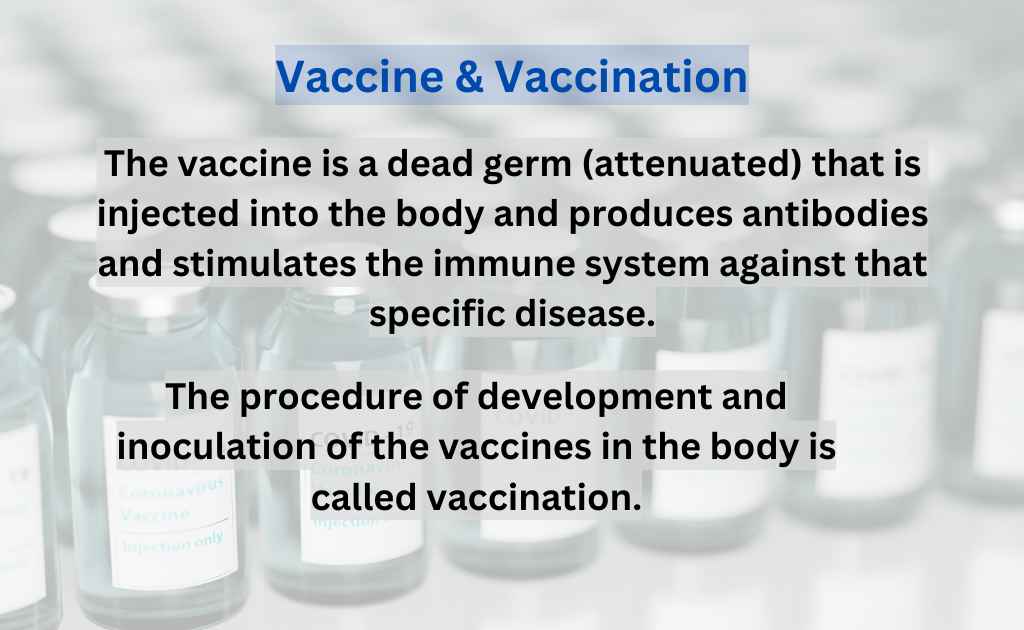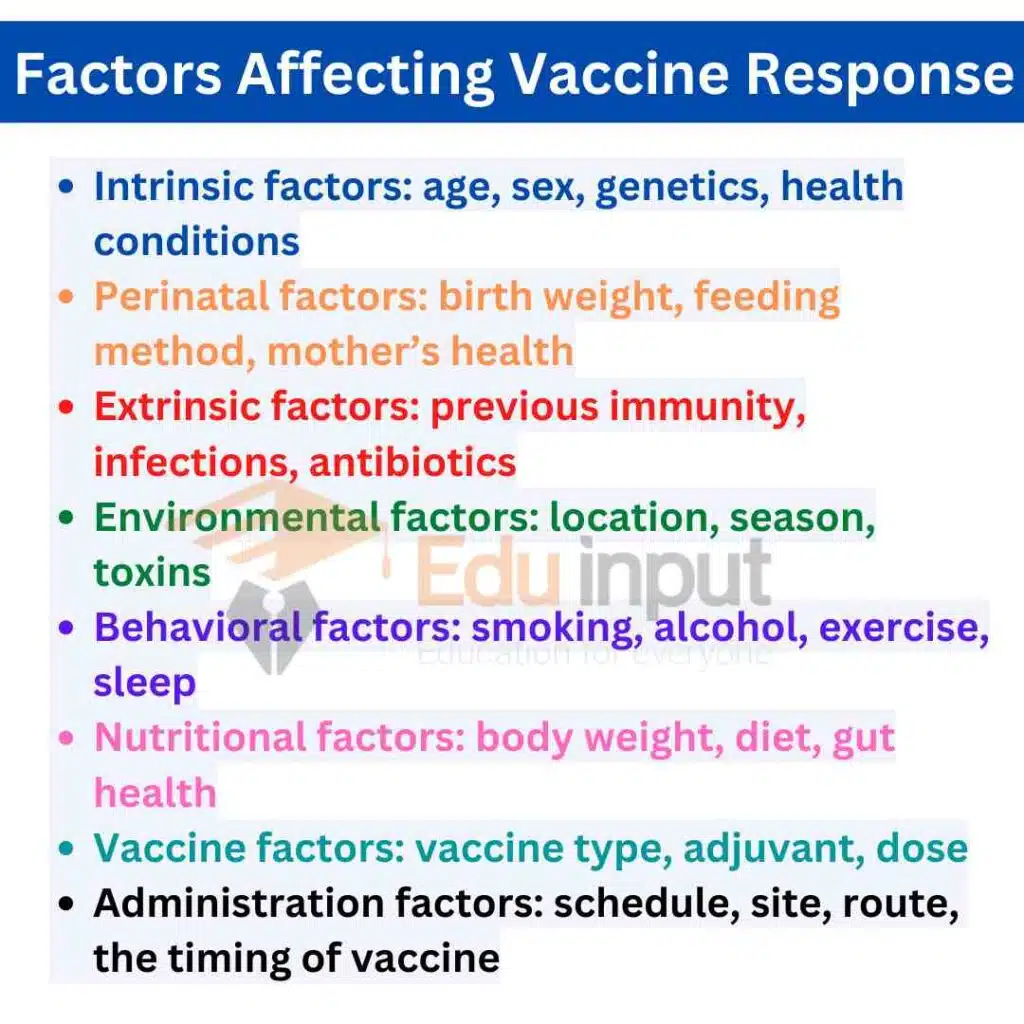Vaccination And Immunization-Definition And History
The vaccine is a dead germ (attenuated) that is injected into the body and produces antibodies and stimulates the immune system against that specific disease. It makes the person immune from the attack of that specific germ, he is being vaccinated for.
A vaccine is typically a dead or weakened form of a specific germ, such as a Virus or bacteria, that is injected into the body. This triggers the immune system to produce antibodies, which then protect the individual from future infections caused by that particular germ.
Louis Pasteur is one of the most important names who has made great breakthroughs in the history of medicine. He made significant contributions to the development of vaccines against chicken cholera, anthrax, and hydrophobia.

Key Points
- A vaccine is a dead or weakened form of a specific germ that is injected into the body to produce immunity against that specific disease.
- Louis Pasteur made significant contributions to the development of vaccines against chicken cholera, anthrax, and hydrophobia.
- Vaccination is the process of creating and administering a vaccine to an individual.
- Immunization is the development of immunity in the body as a result of vaccination.
- Pasteur discovered that using an attenuated form of a bacteria can stimulate the host to produce antibodies to protect against future infections.
- Pasteur honored Edward Jenner for his contributions in the field of vaccines.
- Pasteur also made a vaccine against Hydrophobia or rabies, a serious and often fatal disease transmitted by animal bites.
Vaccination
The procedure of development and inoculation of the vaccines in the body is called vaccination.
Immunization
The development of immunity in the body as a result of vaccination or living germ is called immunization.
History Of Vaccination
Commonly it is believed that the first-ever vaccine for smallpox was developed by Edward Jenner. But people have been trying to protect themselves from smallpox for centuries, even before the invention of the smallpox vaccine.
Much evidence from history shows that people in India and China used various methods, such as drinking snake venom to develop immunity against it, or wearing clothing from an infected person, to build immunity against smallpox. These practices were documented as far back as 1742.
In England (1721), Lady Mary Montagu introduces the practice of vaccination after observing it in Constantinople as Variolation or grafting. It was all about infecting a person with a mild form of disease intentionally. It was practiced to prevent the person from getting a severe smallpox effect later on. The procedure was effective but also had risks, as 2-3%. As some of those treated with variolation died from the disease.
The same practice of variolation was also reported in Turkey and Denmark before it was introduced in England. Still, origin of variolation is not clear, it seems to have originated in Central Asia and spread to other countries over time.
In America, Another case of variolation was reported, where Cotton Mather used this practice on his wife and children during a smallpox outbreak and it was successful. source
Factors Affecting Vaccine Response
Vaccine response varies from person to person. Following factors can affect how a person’s body responds to vaccines:
- Intrinsic factors: age, sex, genetics, health conditions
- Perinatal factors: birth weight, feeding method, mother’s health
- Extrinsic factors: previous immunity, infections, antibiotics
- Environmental factors: location, season, toxins
- Behavioral factors: smoking, alcohol, exercise, sleep
- Nutritional factors: body weight, diet, gut health
- Vaccine factors: vaccine type, adjuvant, dose
- Administration factors: schedule, site, route, the timing of vaccine, and other drugs given with it. source

Development of Vaccine against Chicken Cholera
In the 1880s, Pasteur isolated the bacteria that cause chicken cholera and grew it in pure culture. He used germ theory of Koch to prove that the isolated bacteria were the cause of the disease. He then arranged experiments for public demonstration, in which he inoculated healthy chickens with his pure culture. To his surprise, the chickens did not become sick and did not die.
Pasteur reviewed his steps of experiments and found that he had accidentally used a several-week-old culture instead of a fresh culture for the public demonstration. He grew this old culture specifically for the demonstration. He soon discovered that bacteria lose their virulence (ability to cause disease) after growing old. But these attenuated or less virulent bacteria can stimulate the host chicken to produce antibodies, which protect the host against infection caused by virulent organisms.
Development of Vaccine against Anthrax
Pasteur next applied his principle of inoculation on anthrax. He used the attenuated anthrax bacteria for the prevention of anthrax, and it worked. He called the attenuated cultures of bacteria vaccines, and the immunization with the attenuated culture of bacteria (vaccine) is called vaccination.
Work of Edward Jenner
Pasteur honored Edward Jenner, who successfully vaccinated a boy against smallpox in 1796. Jenner learned that a milkmaid who milked a cow with cowpox disease did not get affected by smallpox. He tested this hypothesis by inoculating the young boy James Phipps with cowpox-causing material, and then with smallpox-causing material. The boy did not suffer from smallpox, because he has developed immunity against that virus.
Development of a Vaccine against Hydrophobia or Rabies
Pasteur also made a vaccine against hydrophobia or rabies. Rabies is a disease transmitted to people by the biting of rabid animals like dogs and cats. Rabies is a serious and often fatal disease, and the development of a vaccine against it was a breakthrough in public health at that time.
Latest Research About Vaccination
- Scientists have assessed the risk of cervical cancer post-vaccination era, as the prevalence of vaccine-targeted oncogenic high-risk human papillomaviruses decreases. This may lead to a loss of positive predictive value of conventional triage modalities, and studies are needed to understand the contribution of new modalities in vaccinated women. Lessons learned from this research may have implications for risk prediction of all women’s cancers. source
- Scientists have summarized recent advances in the use of bacteria for in situ cancer vaccination, which has generated significant interest due to its ability to elicit strong and systemic antitumor immune responses. This review highlights bacteria’s potential as efficient tumor-targeted delivery vehicles and potent adjuvants and discusses various engineering strategies for designing bacteria-based in situ vaccination. The review also addresses the current challenges and future directions in this field. source
- Scientists have conducted a large-scale study in Sweden that measures the unintended consequences of offering financial incentives for taking the first dose of a COVID-19 vaccine. The study found no negative consequences of financial incentives and can even reject small negative impacts on future vaccination uptake, morals, trust, and perceived safety. These findings inform the academic debate on financial incentives for behavior change and policy-makers who consider using them to change behavior. source
- A study found that mild, non-hospitalized COVID-19 can establish new immunological set-points that affect future immune responses. Recoverees had elevated T cell activation signatures and lower expression of innate immune genes. Male recoverees had higher innate and antibody responses after influenza vaccination compared to healthy males and female recoverees. source



Leave a Reply